The Cosmos
Designs on some vases refer to the Maya cosmos, the orderly and harmonious universe. Many of the design elements within very dense and complicated decorations on vessels can be interpreted and give insight into Maya beliefs about cosmology.
Shapes of vessels were based on their intended functions, which have been inferred from texts on the pots. Cylindrical vases contained beverages such as cacao or atole, a maize gruel, and were drinking vessels. Bowls held semi-liquid foods. Wide flat plates were for solids and sacrificial offerings. Although most of the ceramics probably came from elite burials, heavy use-wear on rims, bases and interior bottoms is evidence that many of the pots were used for food service and in rituals before being placed with the dead. It may be significant that the majority of vessels with cosmological imagery in the Palmer Collection are bowls, rather than cylindrical vases.
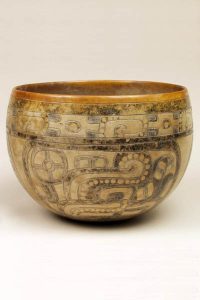
Below the rim is a skyband with repeated k’an cross signs alternating with a beaded blood scroll. Three panels on the bowl’s body contain identical Vision Serpents and k’in signs with attachments. Beads of blood on the tail symbolize the substance that causes the serpent to materialize.
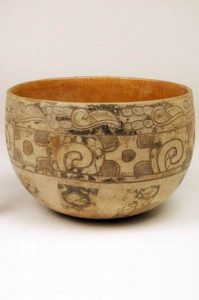
Classic Nebaj
A repeating floral design appears in the band immediately below the rim. The skyband around the center of the bowl alternates the k’an cross, meaning “sky” or representing precious “yellow,” with a beaded scroll, representing blood.
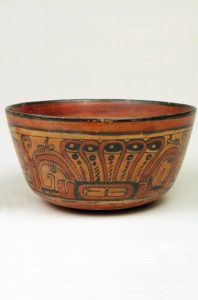
Classic lowland Guatemala
Two panels contain representations of the Waterlily Monster, the personification of lakes, swamps and other bodies of still water. Spouting from its head are tubers, pads and blossoms. Inset in the forehead is a k’in glyph, meaning “sun.”
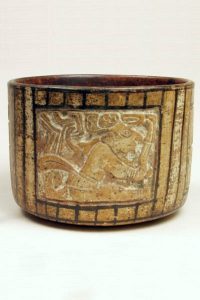
Late Classic San Augustín Acasaguastlán
Two carved panels contain figures of unidentified supernatural beings. The god seated with extended legs wears a k’an cross symbol at the back of his turban and is probably a sky diety. The god seated with crossed legs wears a hatched symbol at the back of his turban. A pointed instrument, perhaps a blood-letting perforator associated with visions and summoning the ancestors, is aimed at his groin. A pair of glyphs appears on each side of the vase.
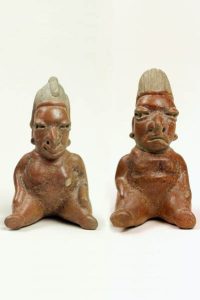
Kaminaljuyú
The different facial expressions of these twin figures indicate that they represent opposition. Both twins and oppositions are at the heart of Maya cosmological thought and paired gods are common in religious imagery.
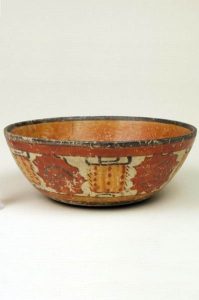
Late Classic Jaina
Conch shell sections (yax, meaning “blue-green” or “first”) and incense burner designs alternate around the body of the bowl. In Maya art cut-shell pectorals are worn by four Pawahtúns, who hold up the corners of the world. The design also is associated with scribes and Xbalanque (also known as Yax-Balam), one of the Hero Twins.
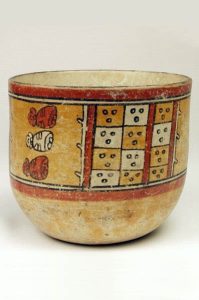
Classic Nebaj
Three panels contain a single glyph repeated three times. Within a checkerboard pattern of squares are triangles of three small circles, probably derived from the day sign kawak, and referring to sacred stones. The pattern represents the three stones of the Cosmic Hearth, set at the center of the universe as the gods’ first act during the creation of the world. Three stars in the constellation Orion (viewed as a turtle by the Maya) are identified as the hearthstones.
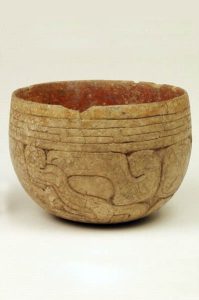
Classic
Two panels below a decorative band contain identical Vision Serpents with k’an cross signs, referring to the sky. The Vision Serpent represents the path out of Xibalbá followed by dead ancestors and gods when conjured by bloodletting rituals.
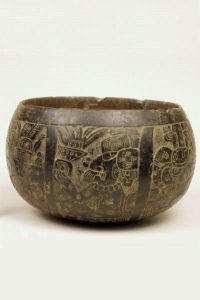
Classic
Earflares worn by each of the six figures on this bowl are k’in signs, representing the sun. The skin of the figures has both jaguar spots and god markings. All six figures are the Jaguar Sun God and represent the sun as a celestial body. The sun was also the symbol of the younger of the Hero Twins, Xbalanque.
